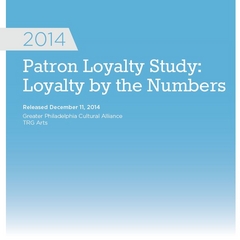Community Arts Research
Thriving organizations supported by loyal patrons
Patrons vote with their time and dollars. Though much can be learned by surveying arts audiences, a patron’s purchase and donation history cuts through assumptions about what they value.
The arts industry can learn by studying how people attend and give to the arts organizations in their community. Through primary research of our client organizations and community networks, as well as a formal partnership with the National Center for Arts Research, TRG regularly releases findings to the field based on arts transactional research.
What do you want to learn? Whether you are a group of arts organizations, a service organization or a foundation, TRG wants to listen to your burning questions and explore the answers that data can provide. Email
to start a conversation.
Ready to get started? Talk to us today
about the best partnership for your needs.
Schedule a call with TRG
What do you want to know?
TRG’s team of analysts are infinitely curious. Whether you are part of a consortium of arts organizations, a foundation or an arts service organization, we welcome an exploration of how to leverage the data in your combined ticketing and fundraising systems into actionable analysis for the community. This best practice approach will allow you to take steps to maximize your organization’s revenue potential, while building loyalty with your patrons.
Need ideas?
Below are some projects we have done or would like to do in arts communities.
Community Patron Loyalty Index (PLI)
How stable is the base of arts supporters in your community? This study looks at the relative loyalty of arts patrons in a given community, using their purchase and donation histories. Utilizing TRG’s Patron Loyalty Index scoring tool, this research project answers practical questions about the health of your community.
- How reliant is your arts community on donations and ticket purchases from a small number of highly-active “advocate” supporters?
- What loyalty behaviors hold true, across the patrons of your various organizations, which might inform marketing and development strategies in your community?
- Are there common customers between organizations that demonstrate loyalty to the sector at large? What characteristics make them stand out?
- Does your community have a solid base of “buyers” who could be cultivated into the next generation of advocates for our arts organizations?
- What percentage of your community arts attendees are “tryers” who have limited investment in the arts?
Example: Community PLI project

2014 Patron Loyalty Study
17 arts organizations. Seven years of data. Nearly 1 million arts patrons. One community. Learn what we found about community engagement in Philadelphia by profiling audience loyalty within each individual organization, and tracking loyal behavior across the community.
Read more>>
Patron Trend Analysis
This study seeks to understand what is happening to arts patronage in a community over time. It looks at both the type of purchase (single ticket, subscriber, member, donor, etc.) and the type of patron (new-to-file, multi-buyer, etc.) in an effort to learn more about their behavior.
- How has patron behavior changed over time? Have ticket-buying, subscription, giving, etc. been declining, increasing or staying stagnant?
- How many brand new arts consumers were created over the study period, by year and in total?
- What is the proportion of multi-buying arts consumers (purchases across multiple arts organizations) over the study period?
- What proportion of arts consumers stopped attending over the study period?
- What is the proportion of local, regional and national buyers over time?
- What demographic and behavioral arts consumer clusters appear in the dataset?
Community Composition Analysis
This study provides a solid overview of the current arts consumers in your community, spanning geographic, demographic and multi-buying behaviors.
- What is demographic/psychographic composition of arts consumers? Includes variables such as age, presence of children, net worth, marital status, interests/hobbies, ethnicity and many more.
- What zip codes contain the highest percentage of arts consumers? What zip codes are most heavily-penetrated, and which have more market opportunity?
- Which organizations share patrons with one another and to what degree? Where is the highest crossover?
- How many patrons attend multiple arts organizations in your community?
"The reporting functionality of the TRG Data Center allowed us to build a patron profile for our community and debunk myths about who our patrons are and how they consume culture. The community insights derived from these reports represent the first of their kind for our community."
Maura Sheffler
Director of Community Programs
The Arts Community Alliance, Dallas
|
Patron Origination Analysis
Where do new arts patrons come from in your community? On any given day/night, thousands of patrons attend an arts organization for the first time. This study looks at what percentage of your community’s arts consumers fall into these four distinct categories:
- Renewals – Last year’s audience members
- Reactivated – Returning audience members from past seasons (didn’t come last year)
- Community Arts – First-time patrons who also attend other arts organizations in your area
- New to File – First-time patrons with no transactional history with any arts organization in your community
Example: past patron origination research
We ran a nation-wide analysis in 2011 about who in attendance at an arts event has been there before. The answer? Only about half. We say “only” because the prevailing conventional wisdom was that most patrons—75% or more—are repeat ticket buyers, subscribers, or members. In fact there are so many new patrons in America’s audiences that we dubbed it, Every Night is Opening Night. See a 6-minute video presentation on the study here: